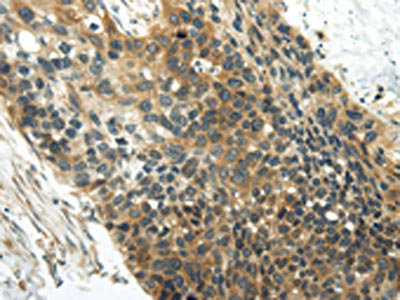
The image on the left is immunohistochemistry of paraffin-embedded Human esophagus cancer tissue using CSB-PA176759(WISP1 Antibody) at dilution 1/25, on the right is treated with synthetic peptide. (Original magnification: x200)
WISP1 Antibody

CSB-PA176759
ApplicationsELISA, ImmunoHistoChemistry
Product group Antibodies
ReactivityHuman
TargetCCN4
Overview
- SupplierCusabio
- Product NameWISP1 Antibody
- Delivery Days Customer20
- ApplicationsELISA, ImmunoHistoChemistry
- CertificationResearch Use Only
- ClonalityPolyclonal
- ConjugateUnconjugated
- Gene ID8840
- Target nameCCN4
- Target descriptioncellular communication network factor 4
- Target synonymsCCN family member 4; WISP1; WISP1 3'UTR-associated RNA 1; WISP1 overlapping transcript 1 (non-protein coding); WISP1c; WISP1i; WISP1-OT1; WISP1tc; WISP1-UT1; WNT1 induced secreted protein 1; WNT1 inducible signaling pathway protein 1
- HostRabbit
- IsotypeIgG
- Protein IDO95388
- Protein NameWNT1-inducible-signaling pathway protein 1
- Scientific DescriptionThis gene encodes a member of the WNT1 inducible signaling pathway (WISP) protein subfamily, which belongs to the connective tissue growth factor (CTGF) family. WNT1 is a member of a family of cysteine-rich, glycosylated signaling proteins that mediate diverse developmental processes. The CTGF family members are characterized by four conserved cysteine-rich domains: insulin-like growth factor-binding domain, von Willebrand factor type C module, thrombospondin domain and C-terminal cystine knot-like domain. This gene may be downstream in the WNT1 signaling pathway that is relevant to malignant transformation. It is expressed at a high level in fibroblast cells, and overexpressed in colon tumors. The encoded protein binds to decorin and biglycan, two members of a family of small leucine-rich proteoglycans present in the extracellular matrix of connective tissue, and possibly prevents the inhibitory activity of decorin and biglycan in tumor cell proliferation. It also attenuates p53-mediated apoptosis in response to DNA damage through activation of the Akt kinase. It is 83% identical to the mouse protein at the amino acid level. Multiple alternatively spliced transcript variants have been identified.
- ReactivityHuman
- Storage Instruction-20°C or -80°C
- UNSPSC12352203
